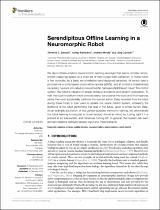JavaScript is disabled for your browser. Some features of this site may not work without it.
- ResearchSpace
- →
- Research Publications/Outputs
- →
- Journal Articles
- →
- View Item
| dc.contributor.author |
Stewart, TC

|
|
| dc.contributor.author |
Kleinhans, A

|
|
| dc.contributor.author |
Mundy, A

|
|
| dc.contributor.author |
Conradt, J

|
|
| dc.date.accessioned | 2016-06-27T08:34:26Z | |
| dc.date.available | 2016-06-27T08:34:26Z | |
| dc.date.issued | 2016-02 | |
| dc.identifier.citation | Stewart, T.C. Kleinhans, A. Mundy, A. and Conradt, J. 2016. Serendipitous offline learning in a neuromorphic robot. Frontiers in Neurorobotics, 10(1) | en_US |
| dc.identifier.issn | 1662-5218 | |
| dc.identifier.uri | http://journal.frontiersin.org/article/10.3389/fnbot.2016.00001/full | |
| dc.identifier.uri | http://hdl.handle.net/10204/8562 | |
| dc.description | Copyright: 2015 Frontiers Media | en_US |
| dc.description.abstract | We demonstrate a hybrid neuromorphic learning paradigm that learns complex senso-rimotor mappings based on a small set of hard-coded reflex behaviors. A mobile robot is first controlled by a basic set of reflexive hand-designed behaviors. All sensor data is provided via a spike-based silicon retina camera (eDVS), and all control is implemented via spiking neurons simulated on neuromorphic hardware (SpiNNaker). Given this control system, the robot is capable of simple obstacle avoidance and random exploration. To train the robot to perform more complex tasks, we observe the robot and find instances where the robot accidentally performs the desired action. Data recorded from the robot during these times is then used to update the neural control system, increasing the likelihood of the robot performing that task in the future, given a similar sensor state. As an example application of this general-purpose method of training, we demonstrate the robot learning to respond to novel sensory stimuli (a mirror) by turning right if it is present at an intersection, and otherwise turning left. In general, this system can learn arbitrary relations between sensory input and motor behavior. | en_US |
| dc.language.iso | en | en_US |
| dc.publisher | Frontiers Media | en_US |
| dc.relation.ispartofseries | Workflow;16483 | |
| dc.subject | Adaptive systems | en_US |
| dc.subject | Mobile robotics | en_US |
| dc.subject | Neurocontrollers | en_US |
| dc.subject | Neuromorphics | en_US |
| dc.subject | Robot control | en_US |
| dc.title | Serendipitous offline learning in a neuromorphic robot | en_US |
| dc.type | Article | en_US |
| dc.identifier.apacitation | Stewart, T., Kleinhans, A., Mundy, A., & Conradt, J. (2016). Serendipitous offline learning in a neuromorphic robot. http://hdl.handle.net/10204/8562 | en_ZA |
| dc.identifier.chicagocitation | Stewart, TC, A Kleinhans, A Mundy, and J Conradt "Serendipitous offline learning in a neuromorphic robot." (2016) http://hdl.handle.net/10204/8562 | en_ZA |
| dc.identifier.vancouvercitation | Stewart T, Kleinhans A, Mundy A, Conradt J. Serendipitous offline learning in a neuromorphic robot. 2016; http://hdl.handle.net/10204/8562. | en_ZA |
| dc.identifier.ris | TY - Article AU - Stewart, TC AU - Kleinhans, A AU - Mundy, A AU - Conradt, J AB - We demonstrate a hybrid neuromorphic learning paradigm that learns complex senso-rimotor mappings based on a small set of hard-coded reflex behaviors. A mobile robot is first controlled by a basic set of reflexive hand-designed behaviors. All sensor data is provided via a spike-based silicon retina camera (eDVS), and all control is implemented via spiking neurons simulated on neuromorphic hardware (SpiNNaker). Given this control system, the robot is capable of simple obstacle avoidance and random exploration. To train the robot to perform more complex tasks, we observe the robot and find instances where the robot accidentally performs the desired action. Data recorded from the robot during these times is then used to update the neural control system, increasing the likelihood of the robot performing that task in the future, given a similar sensor state. As an example application of this general-purpose method of training, we demonstrate the robot learning to respond to novel sensory stimuli (a mirror) by turning right if it is present at an intersection, and otherwise turning left. In general, this system can learn arbitrary relations between sensory input and motor behavior. DA - 2016-02 DB - ResearchSpace DP - CSIR KW - Adaptive systems KW - Mobile robotics KW - Neurocontrollers KW - Neuromorphics KW - Robot control LK - https://researchspace.csir.co.za PY - 2016 SM - 1662-5218 T1 - Serendipitous offline learning in a neuromorphic robot TI - Serendipitous offline learning in a neuromorphic robot UR - http://hdl.handle.net/10204/8562 ER - | en_ZA |






